Stability and Tribological Performance of Nanostructured 2D Turbostratic Graphite and Functionalised Graphene as Low-Viscosity Oil Additives
Abstract
:1. Introduction
2. Materials and Methods
3. Results
4. Conclusions
- The stability of the GBC particles dispersed in POE oil was superior to that of the GSF and GNH particles. Even after an equivalent time of one year, the GBC particles remained suspended in the oil.
- None of the particles was able to significantly modify the friction coefficient of the tribological system used in this work. This was probably because the POE oil, even in the severe conditions tested, still controlled the friction coefficient.
- However, adding the particles in the POE oil reduced the wear rate on the counter-bodies by a value between 50 and 60%. Therefore, the only carbon material that reduced the total wear of the system wear was GBC.
- The superior performance of GBC as a lubrication additive may be associated with its higher stability in the POE oil, which prevents the formation of agglomerates and facilitates its penetration in the contact interface. In addition, the higher level of disorder in the crystalline structure of this type of particle may enable the formation of carbon-rich tribolayers on surfaces.
Author Contributions
Funding
Data Availability Statement
Acknowledgments
Conflicts of Interest
References
- ENERDATA. Total energy consumption |Global Energy Statistical Yearbook 2020| Enerdata. 2020. Available online: https://yearbook.enerdata.net/total-energy/world-consumption-statistics.html (accessed on 15 December 2022).
- Holmberg, K.; Kivikytö-Reponen, P.; Härkisaari, P.; Valtonen, K.; Erdemir, A. Global energy consumption due to friction and wear in the mining industry. Tribol Int. 2017, 115, 116–139. [Google Scholar] [CrossRef]
- Holmberg, K.; Erdemir, A. The impact of tribology on energy use and CO2 emission globally and in combustion engine and electric cars. Tribol Int. 2019, 135, 389–396. [Google Scholar] [CrossRef]
- Holmberg, K.; Erdemir, A. Influence of tribology on global energy consumption, costs and emissions. Friction 2017, 5, 263–284. [Google Scholar] [CrossRef] [Green Version]
- De Mello, J.D.B.; Binder, C.; Binder, R.; Klein, A.N. Effect of precursor content and sintering temperature on the scuffing resistance of sintered self lubricating steel. Wear 2011, 271, 1862–1867. [Google Scholar] [CrossRef]
- Erdemir, A. Review of engineered tribological interfaces for improved boundary lubrication. Tribol Int. 2005, 38, 249–256. [Google Scholar] [CrossRef]
- Studt, P. Boundary lubrication: Adsorption of oil additives on steel and ceramic surfaces and its influence on friction and wear. Tribol Int. 1989, 22, 111–119. [Google Scholar] [CrossRef]
- Canter, B.N. Special Report: Trends in extreme pressure additives. Tribol. Lubr. Technol. 2007, 63, 10–12; 14–18. [Google Scholar]
- Anand, A.; Irfan Ul Haq, M.; Vohra, K.; Raina, A.; Wani, M.F. Role of Green Tribology in Sustainability of Mechanical Systems: A State of the Art Survey. Mater Today Proc. 2017, 4, 3659–3665. [Google Scholar] [CrossRef]
- Wong, V.W.; Tung, S.C. Overview of automotive engine friction and reduction trends–Effects of surface, material, and lubricant-additive technologies. Friction 2016, 4, 1–28. [Google Scholar] [CrossRef] [Green Version]
- Tang, Z.; Li, S. A review of recent developments of friction modifiers for liquid lubricants (2007-present). Curr Opin Solid State Mater Sci. 2014, 18, 119–139. [Google Scholar] [CrossRef]
- Bordignon, R.; Salvaro, D.; Binder, C.; Klein, A.N.; Drago, V.; de Mello, J.D.B. Tribological Behaviour of Plasma-Functionalized Graphene as Low-Viscosity Oil Additive. Tribol. Lett. 2018, 66, 114. [Google Scholar] [CrossRef]
- Saxena, N.D.; Chauhan, N.R. Nanomaterial in Lubricants—A Real Approach; Lecture Notes in Mechanical Engineering; Springer: Singapore, 2019; pp. 847–854. [Google Scholar] [CrossRef]
- Pierson, H.O. Handbook of Carbon, Graphite, Diamond and Fullerenes: Properties, Processing and Applications; William Andrew: Norwich, NY, USA, 1993. [Google Scholar]
- Zhai, W.; Srikanth, N.; Kong, L.B.; Zhou, K. Carbon nanomaterials in tribology. Carbon 2017, 119, 150–171. [Google Scholar] [CrossRef]
- Wang, H.; Gao, Q. Synthesis, characterization and energy-related applications of carbide-derived carbons obtained by the chlorination of boron carbide. Carbon 2009, 47, 820–828. [Google Scholar] [CrossRef]
- Georgakilas, V.; Perman, J.A.; Tucek, J.; Zboril, R. Broad Family of Carbon Nanoallotropes: Classification, Chemistry, and Applications of Fullerenes, Carbon Dots, Nanotubes, Graphene, Nanodiamonds, and Combined Superstructures. Chem. Rev. 2015, 115, 4744–4822. [Google Scholar] [CrossRef]
- Schoonheydt, R.A.; Pinnavaia, T.O.M.; Lagaly, G.; Gangas, N.; Kiel, È.; Chemie, È.A. ADVANCED MATERIALS SUBCOMMITTEE * Pillared clays and pillared layered solids (Technical Report) Abstract: Pillaring is a commonly used procedure to transform a layered crystalline inorganic Layered compound. Pure Appl. Chem. 1999, 71, 2367–2371. [Google Scholar] [CrossRef]
- Chouhan, A.; Mungse, H.P.; Sharma, O.P.; Singh, R.K.; Khatri, O.P. Chemically functionalized graphene for lubricant applications: Microscopic and spectroscopic studies of contact interfaces to probe the role of graphene for enhanced tribo-performance. J. Colloid Interface Sci. 2018, 513, 666–676. [Google Scholar] [CrossRef]
- Ismail, N.A.; Bagheri, S. Highly oil-dispersed functionalized reduced graphene oxide nanosheets as lube oil friction modifier. Mater. Sci. Eng. B Solid-State Mater. Adv. Technol. 2017, 222, 34–42. [Google Scholar] [CrossRef]
- Chun, Y.; Lim, D. Carbide derived carbon: From growth to tribological application. J. Ceram. Soc. Jpn. 2014, 122, 577–585. [Google Scholar] [CrossRef] [Green Version]
- Rivera, N.A.; Neves, G.O.; Giacomelli, R.O.; Salvaro, D.; Binder, C.; Klein, A.N.; de Mello, J.B.D. Dry tribological performance of nanostructured 2D turbostratic graphite particles derived from boron and chromium carbides. Wear 2021, 477, 2–11. [Google Scholar] [CrossRef]
- Neves, G.O.; Araya, N.; Biasoli de Mello, J.D.; Binder, C.; Klein, A.N.; Aguilar, C. Synthesis of nanostructured carbon derived from the solid-state reaction between iron and boron carbide. Mater. Chem. Phys. 2022, 276, 125396. [Google Scholar] [CrossRef]
- Spear, J.C.; Ewers, B.W.; Batteas, J.D. 2D-nanomaterials for controlling friction and wear at interfaces. Nano Today 2015, 10, 301–314. [Google Scholar] [CrossRef] [Green Version]
- Senatore, A.; Agostino, V.D.; Petrone, V.; Ciambelli, P.; Sarno, M. Graphene Oxide Nanosheets as Effective Friction Modifier for Oil Lubricant: Materials, Methods, and Tribological Results. ISRN Tribol. 2013, 2013, 425809. [Google Scholar] [CrossRef] [Green Version]
- Lee, C.G.; Hwang, Y.J.; Choi, Y.M.; Lee, J.K.; Choi, C.; Oh, J.M. A study on the tribological characteristics of graphite nano lubricants. Int. J. Precis. Eng. Manuf. 2009, 10, 85–90. [Google Scholar] [CrossRef]
- Kogovšek, J.; Kalin, M. Various MoS2-, WS2- and C-based micro- and nanoparticles in boundary lubrication. Tribol. Lett. 2014, 53, 585–597. [Google Scholar] [CrossRef]
- Gupta, M.K.; Bijwe, J. A complex interdependence of dispersant in nano-suspensions with varying amount of graphite particles on its stability and tribological performance. Tribol. Int. 2020, 142, 105968. [Google Scholar] [CrossRef]
- Huang, H.D.; Tu, J.P.; Gan, L.P.; Li, C.Z. An investigation on tribological properties of graphite nanosheets as oil additive. Wear 2006, 261, 140–144. [Google Scholar] [CrossRef]
- Xue, C.Y.; Wang, S.R.; Leng, J.F.; Wang, Y.; Wang, G.Q. Tribological Performance of Modified Flocculent Graphite as Lubricant Additives. Surf. Rev. Lett. 2020, 27, 1950108. [Google Scholar] [CrossRef]
- Ali, I.; Basheer, A.A.; Kucherova, A.; Memetov, N.; Pasko, T.; Ovchinnikov, K.; Pershin, V.; Kuznetsov, D.; Galunin, E.; Grachev, V.; et al. Advances in carbon nanomaterials as lubricants modifiers. J. Mol. Liq. 2019, 279, 251–266. [Google Scholar] [CrossRef]
- Cheng, W.L.; Mei, B.J.; Liu, Y.N.; Huang, Y.H.; Yuan, X.D. A novel household refrigerator with shape-stabilized PCM (Phase Change Material) heat storage condensers: An experimental investigation. Energy 2011, 36, 5797–5804. [Google Scholar] [CrossRef]
- Boeng, J.; Melo, C. Mapping the energy consumption of household refrigerators by varying the refrigerant charge and the expansion restriction. Int. J. Refrig. 2014, 41, 37–44. [Google Scholar] [CrossRef]
- Woodward, M.; Berry, C. EIA’s residential energy survey now includes estimates for more than 20 new end uses. EIA Resid. Energy Consum. Surv. 2018, 1–2. Available online: https://www.eia.gov/todayinenergy/detail.php?id=36412 (accessed on 30 January 2023).
- Neves, G.O.; Araya, N.; de Mello, J.D.B.; Binder, C.; Klein, A.N. Synthesis, Characterization and Performance of Nanostructured 2D Turbostratic Graphite Particles Derived from the Solid-State Reaction Between Carbides. Mater. Res. Bull. 2022, 151, 111826. [Google Scholar] [CrossRef]
- Dias, H.W.J.; Medeiros, A.B.; Binder, C.; Neto, J.B.R.; Klein, A.N.; de Mello, J.D.B. Tribological evaluation of turbostratic 2d graphite as oil additive. Lubricants 2021, 9, 43. [Google Scholar] [CrossRef]
- Detloff, T.; Sobisch, T.; Lerche, D. Particle size distribution by space or time dependent extinction profiles obtained by analytical centrifugation. Part. Part. Syst. Charact. 2006, 23, 184–187. [Google Scholar] [CrossRef]
- Cançado, L.G.; Takai, K.; Enoki, T.; Endo, M.; Kim, Y.A.; Mizusaki, H.; Speziali, N.; Jorio, A.; Pimenta, M.A. Measuring the degree of stacking order in graphite by Raman spectroscopy. Carbon 2008, 46, 272–275. [Google Scholar] [CrossRef] [Green Version]
- Pimenta, M.A.; Dresselhaus, G.; Dresselhaus, M.S.; Cançado, L.G.; Jorio, A.; Saito, R. Studying disorder in graphite-based systems by Raman spectroscopy. Phys. Chem. Chem. Phys. 2007, 9, 1276–1291. [Google Scholar] [CrossRef]
- Martins Ferreira, E.H.; Moutinho, M.V.O.; Stavale, F.; Lucchese, M.M.; Capaz, R.B.; Achete, C.A.; Jorio, A. Evolution of the Raman spectra from single-, few-, and many-layer graphene with increasing disorder. Phys. Rev. B Condens. Matter Mater. Phys. 2010, 82, 125429. [Google Scholar] [CrossRef] [Green Version]
- Prusty, K.; Barik, S.; Swain, S.K. A Corelation Between the Graphene Surface Area, Functional Groups, Defects, and Porosity on the Performance of the Nanocomposites. In Functionalized Graphene Nanocomposites and Their Derivatives: Synthesis, Processing and Applications; Elsevier: Amsterdam, The Netherlands, 2018; pp. 265–283. [Google Scholar] [CrossRef]
- Fang, B.; Li, J.; Zhao, N.; Shi, C.; Ma, L.; He, C.; He, F.; Liu, E. Boron doping effect on the interface interaction and mechanical properties of graphene reinforced copper matrix composite. Appl. Surf. Sci. 2017, 425, 811–822. [Google Scholar] [CrossRef]
- Neves, G.O.; Salvaro, D.B.; Bendo, T.; Consoni, D.R.; de Mello, J.D.B.; Binder, C.; Klein, A.N. Carbon Structures and Tribological Properties of Fe-C-SiC Self-Lubricating Metal Matrix Composites Prepared with α/β-SiC Polytypes. Lubricants 2022, 10, 112. [Google Scholar] [CrossRef]
- Dai, W.; Kheireddin, B.; Gao, H.; Liang, H. Roles of nanoparticles in oil lubrication. Tribol. Int. 2016, 102, 88–98. [Google Scholar] [CrossRef]
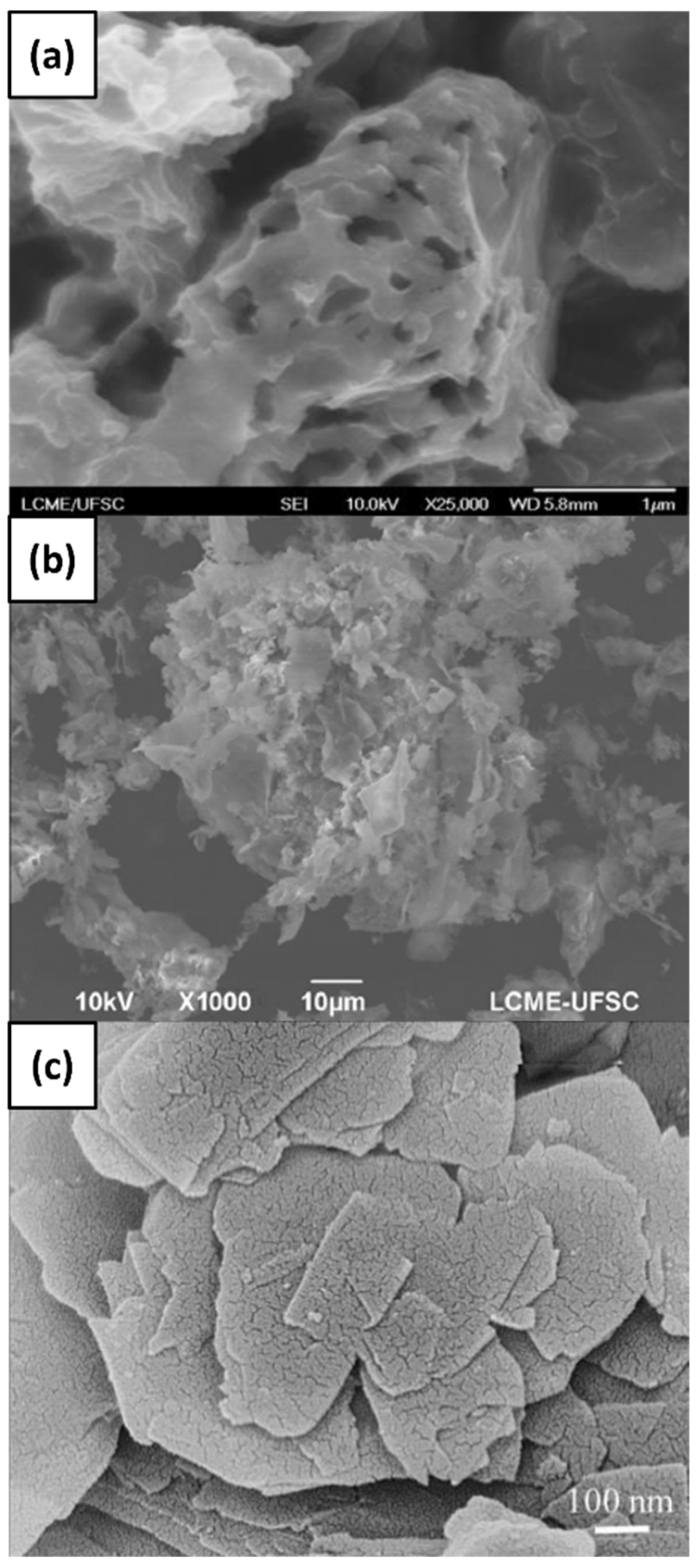
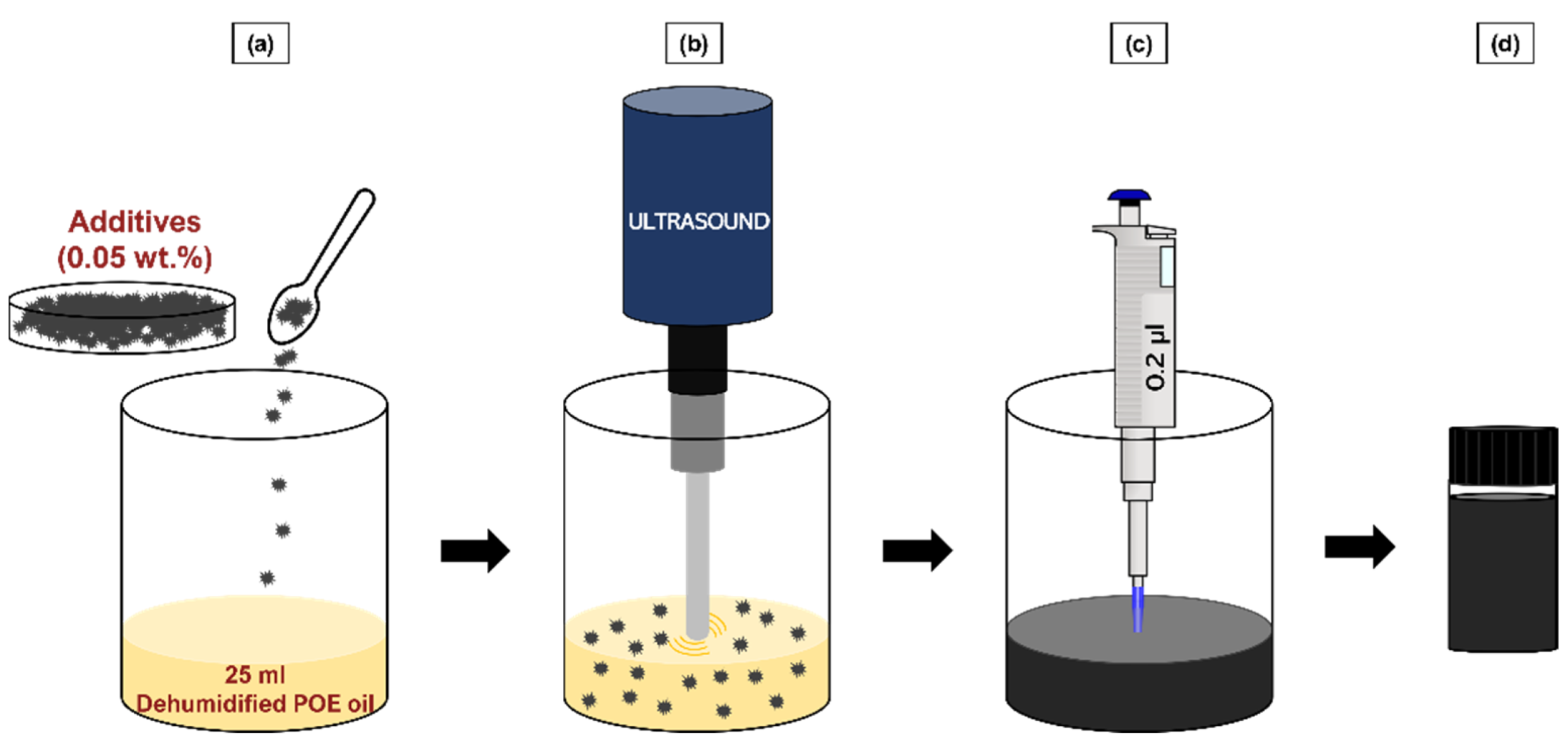

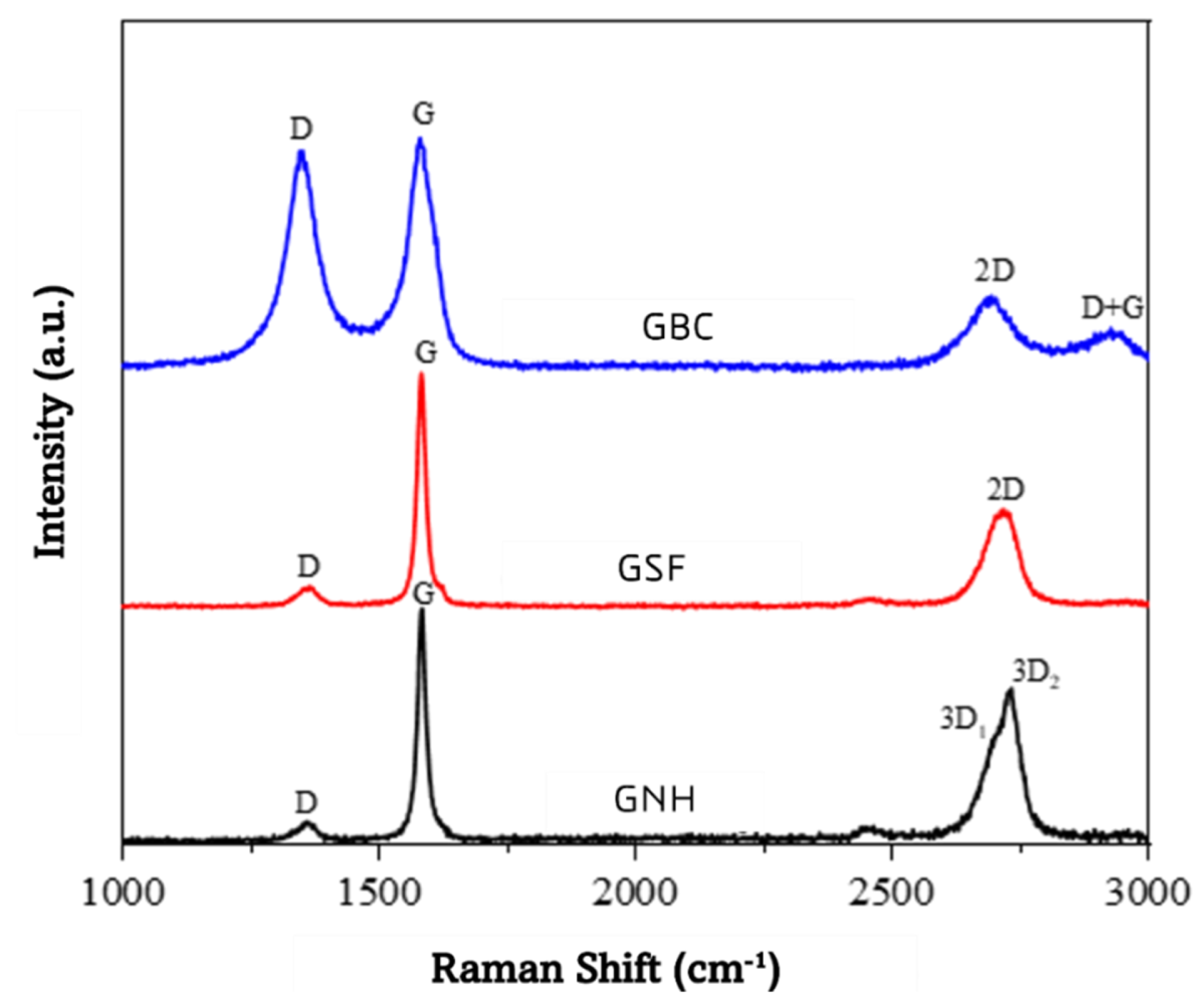


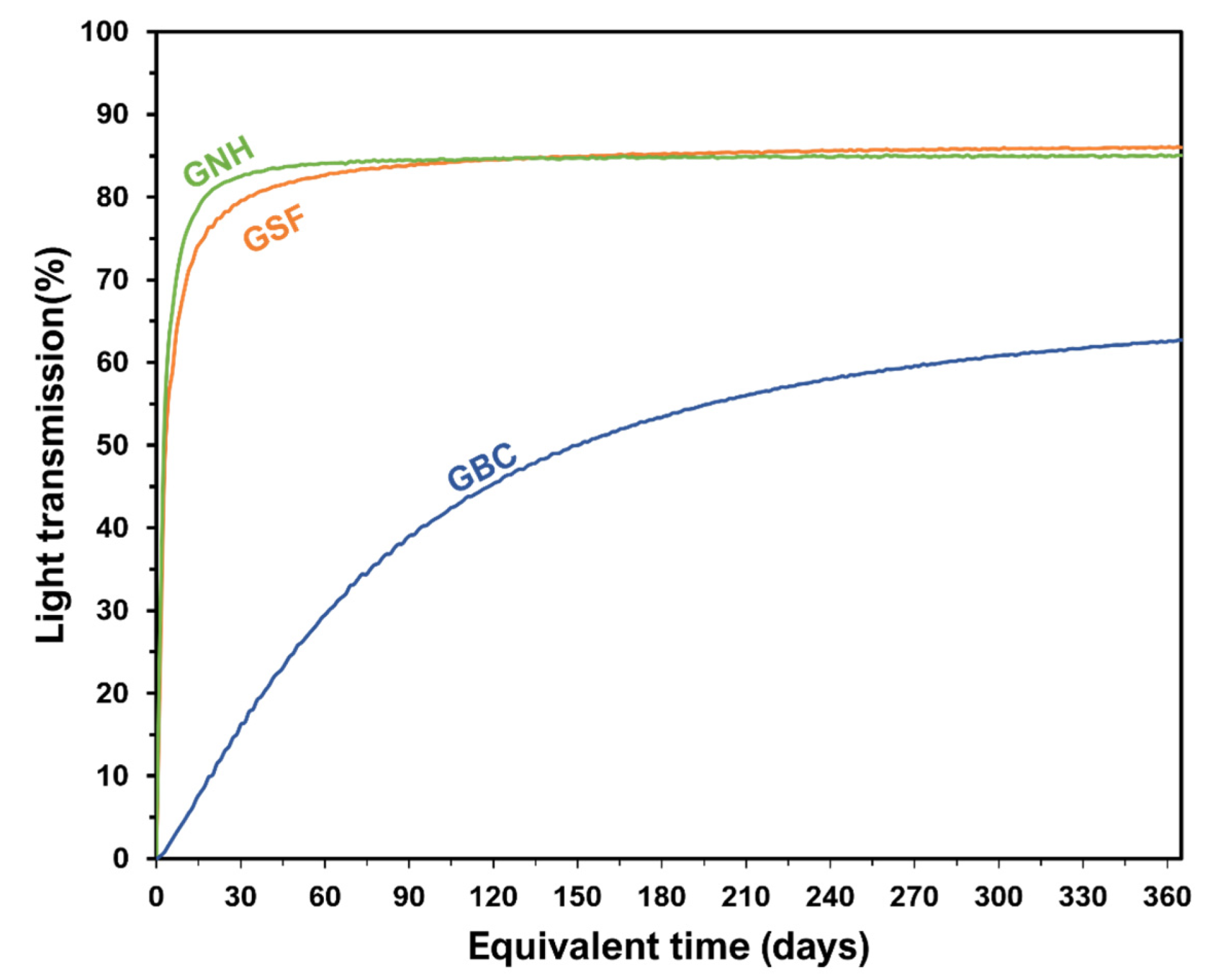
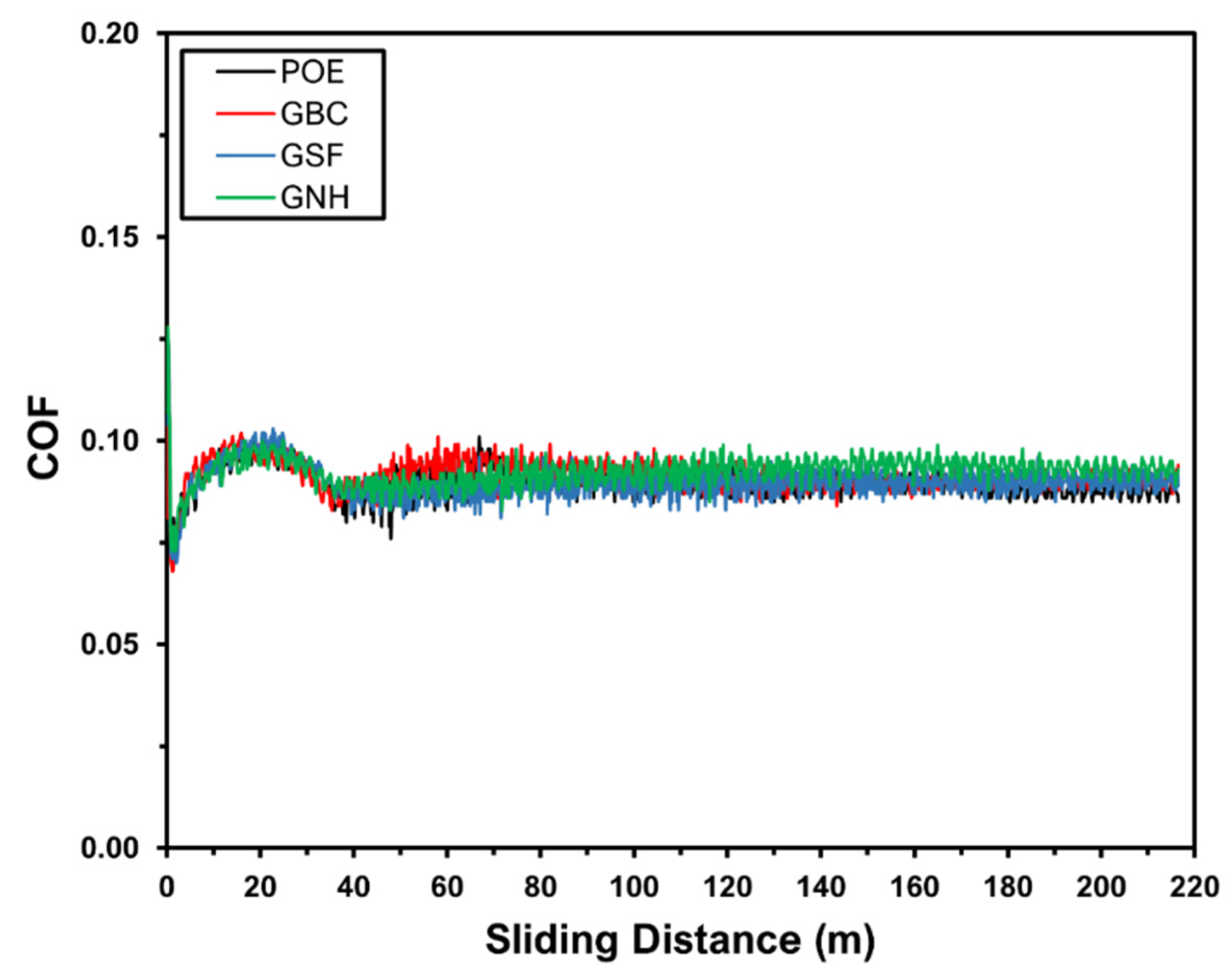
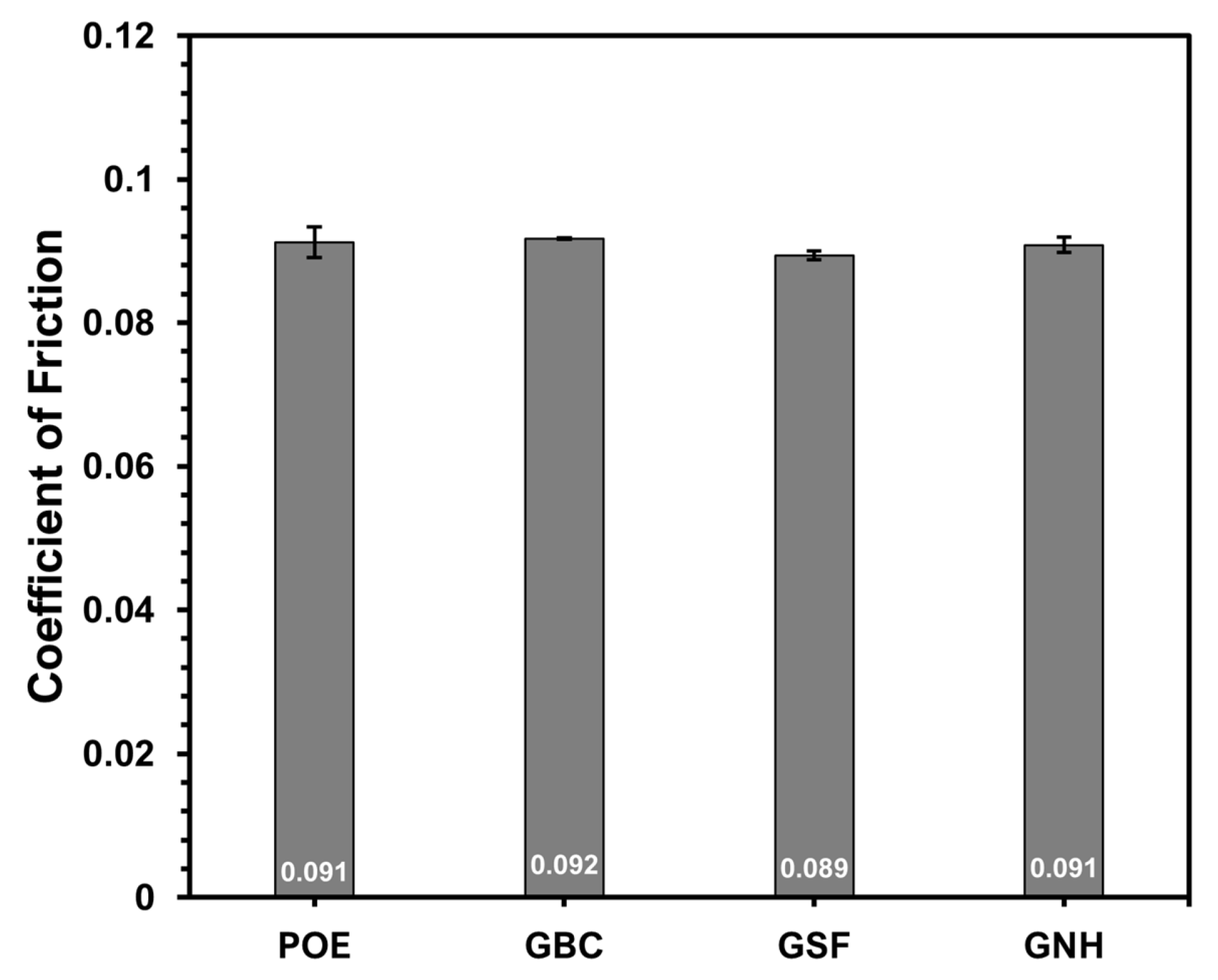
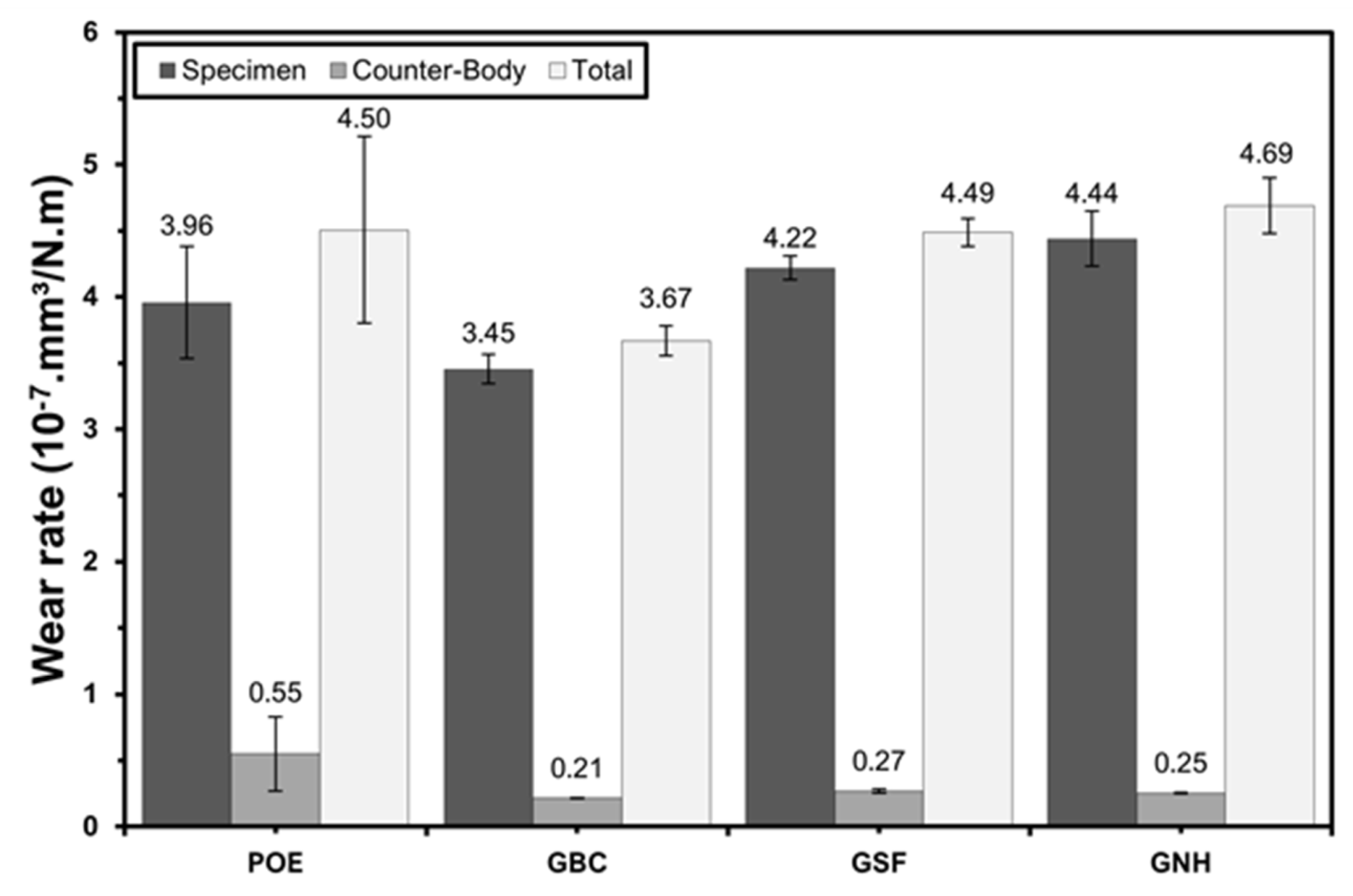

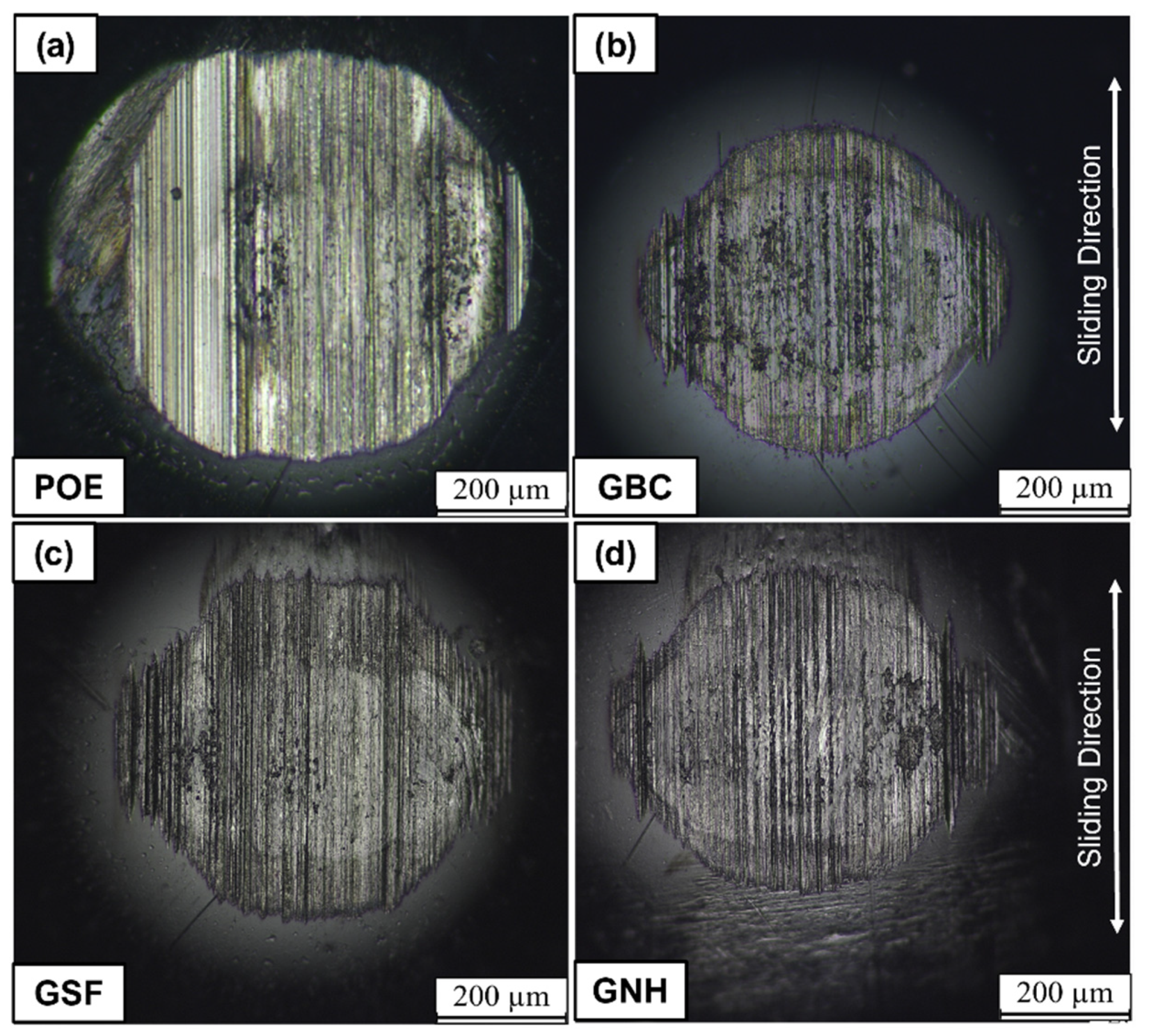
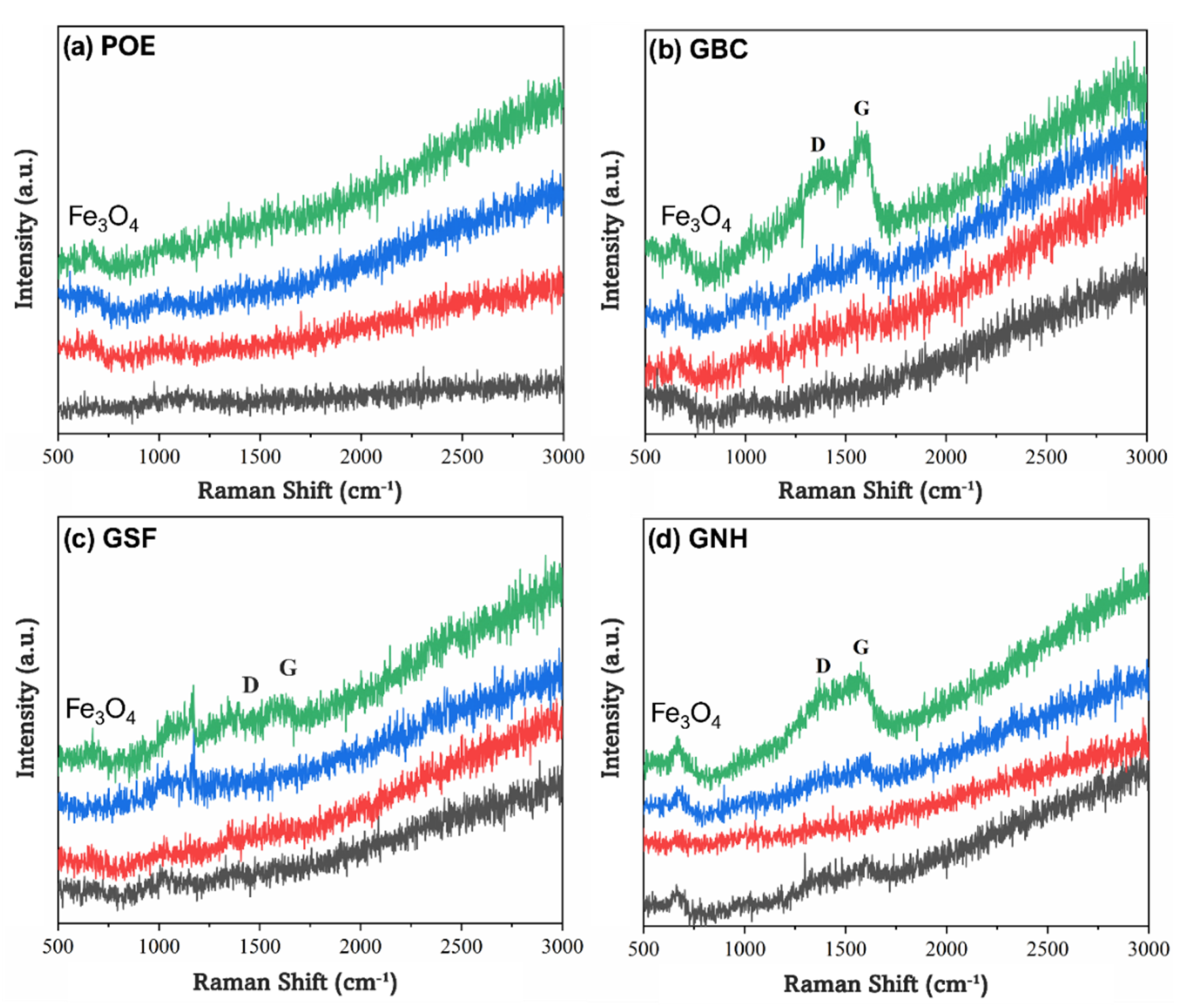
Disclaimer/Publisher’s Note: The statements, opinions and data contained in all publications are solely those of the individual author(s) and contributor(s) and not of MDPI and/or the editor(s). MDPI and/or the editor(s) disclaim responsibility for any injury to people or property resulting from any ideas, methods, instructions or products referred to in the content. |
© 2023 by the authors. Licensee MDPI, Basel, Switzerland. This article is an open access article distributed under the terms and conditions of the Creative Commons Attribution (CC BY) license (https://creativecommons.org/licenses/by/4.0/).
Share and Cite
Lau, G.A.; Neves, G.O.; Salvaro, D.B.; Binder, C.; Klein, A.N.; de Mello, J.D.B. Stability and Tribological Performance of Nanostructured 2D Turbostratic Graphite and Functionalised Graphene as Low-Viscosity Oil Additives. Lubricants 2023, 11, 155. https://doi.org/10.3390/lubricants11040155
Lau GA, Neves GO, Salvaro DB, Binder C, Klein AN, de Mello JDB. Stability and Tribological Performance of Nanostructured 2D Turbostratic Graphite and Functionalised Graphene as Low-Viscosity Oil Additives. Lubricants. 2023; 11(4):155. https://doi.org/10.3390/lubricants11040155
Chicago/Turabian StyleLau, Gustavo Alves, Guilherme Oliveira Neves, Diego Berti Salvaro, Cristiano Binder, Aloisio Nelmo Klein, and José Daniel Biasoli de Mello. 2023. "Stability and Tribological Performance of Nanostructured 2D Turbostratic Graphite and Functionalised Graphene as Low-Viscosity Oil Additives" Lubricants 11, no. 4: 155. https://doi.org/10.3390/lubricants11040155
APA StyleLau, G. A., Neves, G. O., Salvaro, D. B., Binder, C., Klein, A. N., & de Mello, J. D. B. (2023). Stability and Tribological Performance of Nanostructured 2D Turbostratic Graphite and Functionalised Graphene as Low-Viscosity Oil Additives. Lubricants, 11(4), 155. https://doi.org/10.3390/lubricants11040155





